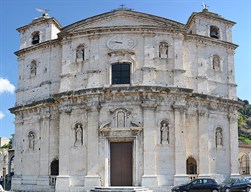Castel di Sangro
 Castel di Sangro, the ancient Aufidena of the Sabelians, can also claim a past of prosperity and political importance. The wealth of the city was primarly based on its wool and iron production and on its pastoral farming which was among the most flourishing of the entire Kingdom of Naples and on account of the importance of its mercantile fairs. A testimony of the importance of Castel di Sangro was that of its officially becoming a city, on 20 October 1744, under King Charles III of Bourbon. The city boasts significant examples of Baroque art such as the Basilica of Santa Maria Assunta. Marble inlays of great elegance, notable wooden sculptures and imposing paintings characterize the inside of the church. The paintings, in particular, testify to the presence in Abruzzo, in the course of the eighteenth century, of numerous artists of the Neapolitan school. Domenico Antonio Vaccaro is the author of the Natività and Gesù tra i dottori (Jesus among the doctors), but alongside them are the paintings of Paolo De Matteis (l’Ultima Cena and the Madonna col Bambino e Santi), Santolo CirilloSantolo Cirillo (1689-1755) was one of the most original so-called minor painters active in Naples and the rest of southern Italy during the eighteenth century. His talent is visible in the Basilica of San Tammaro in Grumo Nevano, his home town, but his frescoes are also conserved in the Cathedral of Naples and that of Capua. He is yet to be studied in depth and some of his paintings have been located outside of the Campania region, for example, in Fermo and Castel di Sangro. (the Serpente di Bronzo and the Miracolo della manna) and Francesco de MuraHighly influenced by the art and technique of Francesco Solimena and Luca Giordano, Francesco de Mura (1696-1782) is, nonetheless, one of the greatest exponents of eighteenth century Neapolitan Baroque art. Among his works are the frescoes for the royal palaces of Turin (where he lived from 1741 to 1743) and of Naples, the Epifania (Epiphany) in the Nunziatella of Naples, the decoration of the church of Santa Chiara in Naples and the Moltiplicazione dei pani (Multiplication of bread) in the Cathedral of Foggia. (Gesù dinanzi a Pilato and the Salita al Calvario). The Neapolitan school is also to be recognised in the numerous wooden sculptures conserved in the basilica, attributed to Giacomo Colombo and Paolo Saverio di Zinno. Colombo, active between the seventeenth and eighteenth centuries, was the disciple of Francesco Solimena, even though the influence of Vaccaro and Fanzago are evident in his works. His masterworks are visible in all the provinces of the old Kingdom of Naples. Paolo Saverio di Zinno, a native of Campobasso, was the disciple of Colombo and worked, above all, in Abruzzo and Molise, throughout the eighteenth century.
Castel di Sangro, the ancient Aufidena of the Sabelians, can also claim a past of prosperity and political importance. The wealth of the city was primarly based on its wool and iron production and on its pastoral farming which was among the most flourishing of the entire Kingdom of Naples and on account of the importance of its mercantile fairs. A testimony of the importance of Castel di Sangro was that of its officially becoming a city, on 20 October 1744, under King Charles III of Bourbon. The city boasts significant examples of Baroque art such as the Basilica of Santa Maria Assunta. Marble inlays of great elegance, notable wooden sculptures and imposing paintings characterize the inside of the church. The paintings, in particular, testify to the presence in Abruzzo, in the course of the eighteenth century, of numerous artists of the Neapolitan school. Domenico Antonio Vaccaro is the author of the Natività and Gesù tra i dottori (Jesus among the doctors), but alongside them are the paintings of Paolo De Matteis (l’Ultima Cena and the Madonna col Bambino e Santi), Santolo CirilloSantolo Cirillo (1689-1755) was one of the most original so-called minor painters active in Naples and the rest of southern Italy during the eighteenth century. His talent is visible in the Basilica of San Tammaro in Grumo Nevano, his home town, but his frescoes are also conserved in the Cathedral of Naples and that of Capua. He is yet to be studied in depth and some of his paintings have been located outside of the Campania region, for example, in Fermo and Castel di Sangro. (the Serpente di Bronzo and the Miracolo della manna) and Francesco de MuraHighly influenced by the art and technique of Francesco Solimena and Luca Giordano, Francesco de Mura (1696-1782) is, nonetheless, one of the greatest exponents of eighteenth century Neapolitan Baroque art. Among his works are the frescoes for the royal palaces of Turin (where he lived from 1741 to 1743) and of Naples, the Epifania (Epiphany) in the Nunziatella of Naples, the decoration of the church of Santa Chiara in Naples and the Moltiplicazione dei pani (Multiplication of bread) in the Cathedral of Foggia. (Gesù dinanzi a Pilato and the Salita al Calvario). The Neapolitan school is also to be recognised in the numerous wooden sculptures conserved in the basilica, attributed to Giacomo Colombo and Paolo Saverio di Zinno. Colombo, active between the seventeenth and eighteenth centuries, was the disciple of Francesco Solimena, even though the influence of Vaccaro and Fanzago are evident in his works. His masterworks are visible in all the provinces of the old Kingdom of Naples. Paolo Saverio di Zinno, a native of Campobasso, was the disciple of Colombo and worked, above all, in Abruzzo and Molise, throughout the eighteenth century.
